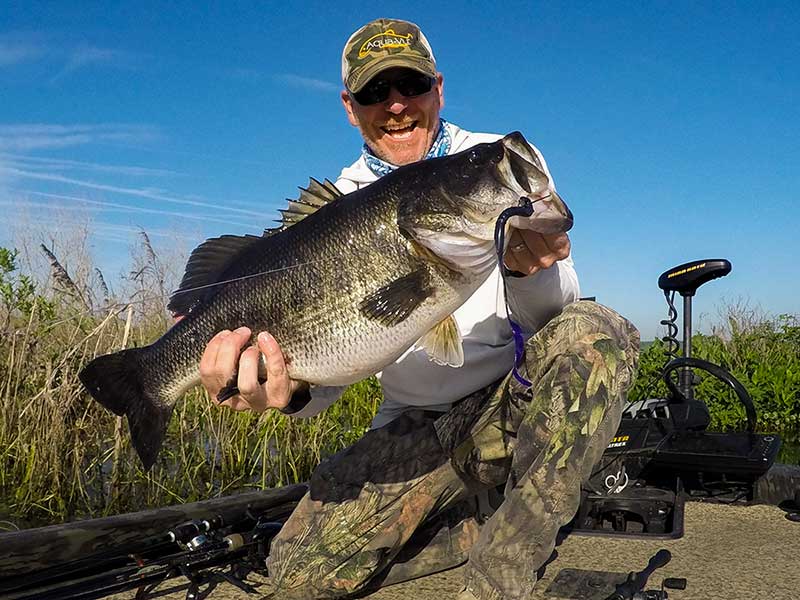Summertime River Bass Fishing: It’s All About the Flow
Picking the right places to make your casts and how to position on river systems.
By: Joe Balog

Old-timers call it "reading the river". Observation built on a basic principle: bass utilize current, but don't like to fight it. Big fish pack on the pounds by letting the river do the work, bringing a constant source of fresh food down the buffet line.
Wiley river fisherman can pick out the sweet spots from above. Current seams form in areas where cover blocks the flow, the river switches directions or swings around an island. A small slack-water area is formed, allowing the bass to lie in wait for the next food item to pass by. On Florida's St. John's River, near my home, those food items come in the form of threadfin shad.
Finding the shad is often easy; they're naturally pushed into swift-water areas. Catching the bass that pursue them, though, is anything but simple. New technology has made the pursuit vastly easier, but let's start at the beginning.
Flow Over Everything
When pursuing summertime river bass, it's important to understand one principle: flow trumps everything. In terms of location, the thickest lilies and prettiest laydowns won't hold a fish, if modest flow isn't offered nearby. For this reason, it's important to concentrate efforts around the current seams we mentioned - out on the main river - and stop wasting time elsewhere.

MEGA Side Imaging® opens up a whole new frontier to discovering hotspots, especially in river environments. My program consists of getting 75 feet or so off the bank, dialing in my Humminbird HELIX Side Imaging to that corresponding range, and slowly cruising downstream. I can cover vast areas of riverbank in a short period of time, marking any piece of current-blocking cover with a quick GPS waypoint. Downed trees are a no-brainer, but I've found numerous isolated shell bars and small rockpiles as well, invisible to passing anglers. It doesn't take much to hold a school of bass if the flow is right.
A case in point, on a recent outing, I found a massive tree under the water at the perfect depth. Casts came back empty, until I discovered a small shell bar behind the tree, in the created current seam. From there, it was game on.
Regardless, it's always best to fish a large area around each marked location. While precise sweet spots can be dialed in quickly out on the lake, in a river, sometimes it's best to keep a bait wet, as things aren't always so obvious.
Positioning and Bait Placement
Nothing - and I mean nothing - has advanced this type of bass fishing more than Spot-Lock® technology from Minn Kota. You see, it's often impossible to distinguish what makes a perfect cast. However, with Spot-Lock, that cast can be immediately duplicated.
To back up, river fishing is unique in that both the lure and line are constantly moving on their own. Current sweeps a bait differently on each cast, therefore resulting in different outcomes. Often times, just a slight difference in angle produces more or less line drag, and therefore a different lure action.

River bass fishing is plastic worm territory; nothing will catch more fish over the long haul. The standard Texas-rig continues to produce, especially around trees and snaggy cover. The key here is to use enough weight to quickly reach the bottom, but still, allow the bait to tumble in the current.
My favorite river worm rig, however, has become the swing-head. Here, a free-swinging football head attaches in Texas-Rig fashion, with an oversized wide-gap hook. The real key to fishing the swing-head is to continuously move the lure on the bottom - dragging and grinding it like a crankbait. Don't lift and hop - it defeats the built-in action from bottom contact.

I alter between straight-tail worms and an old-school paddle tail, both in Junebug color, a Florida favorite. Once a productive area is recognized, I stay downstream, making casts directly with the current, out to about a 45-degree angle.
Often times, the lure must "swing in" to the cover with the natural flow, to get bit. Once it does, I immediately engage Spot-Lock on my Ultrexâ„¢ trolling motor foot-pedal. From there, I can fish in a rock-solid position further back on the deck, and duplicate my cast, exactly.
Should I need to adjust the boat, I do so by using the Spot-Lock Jog feature to shift my boat position in five-foot increments with my i-Pilot® remote. I often regain contact with the school, or offer just a slight alteration on my cast, resulting in several more fish catches.
Again, I can do this from anywhere in the boat, using my remote.
River bass are feast and famine - dictated more by the current itself than anything.
Don't fight it. Instead, use technology to read the river, and uncover the secrets beneath.







